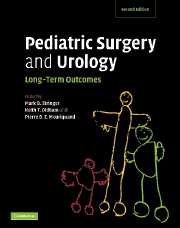Book contents
- Frontmatter
- Contents
- List of contributors
- Acknowledgments
- Preface
- Part I General issues
- Part II Head and neck
- Part III Thorax
- 11 Chest wall deformities
- 12 Congenital diaphragmatic hernia
- 13 Surgical management of airway obstruction
- 14 Pulmonary resection and thoracotomy
- 15 Esophageal atresia
- 16 Antireflux procedures
- 17 Esophageal replacement
- 18 Esophageal achalasia
- 19 Congenital malformations of the breast
- Part IV Abdomen
- Part V Urology
- Part VI Oncology
- Part VII Transplantation
- Part VIII Trauma
- Part IX Miscellaneous
- Index
- Plate section
- References
19 - Congenital malformations of the breast
from Part III - Thorax
Published online by Cambridge University Press: 08 January 2010
- Frontmatter
- Contents
- List of contributors
- Acknowledgments
- Preface
- Part I General issues
- Part II Head and neck
- Part III Thorax
- 11 Chest wall deformities
- 12 Congenital diaphragmatic hernia
- 13 Surgical management of airway obstruction
- 14 Pulmonary resection and thoracotomy
- 15 Esophageal atresia
- 16 Antireflux procedures
- 17 Esophageal replacement
- 18 Esophageal achalasia
- 19 Congenital malformations of the breast
- Part IV Abdomen
- Part V Urology
- Part VI Oncology
- Part VII Transplantation
- Part VIII Trauma
- Part IX Miscellaneous
- Index
- Plate section
- References
Summary
Introduction
The mammary glands begin their development early in organogenesis and progress through several developmental stages, both in the uterus and in subsequent life. From a biologic standpoint, the mammary glands serve as a source of nourishment and provide passive immunity to our offspring. From a social perspective, mammary glands serve as a means of nurturing these bonds between mother and infant. In addition, they play an important role in defining femininity and our perceptions of beauty and attraction.
The importance of normal breast development can be demonstrated further by the psychosocial impact that results when normal development is interrupted. Congenital breast malformations may become manifest at different stages of breast development. These can be characterized in terms of symmetry, shape variations, over- or underdevelopment, multiple sites of development, unilateral development, or absence of development. Abnormal breast development may affect either sex. In this chapter, we will discuss normal breast development in more detail as well as some of the more common congenital breast disorders encountered in the pediatric population.
Breast development
The development of the mammary glands is initially identical for both sexes, and is a result of complex interplay of growth factors including TGF-α, TGF-β1, tenascin-C and extracellular matrix proteins such as collagen IV during organogenesis. This interplay begins in the fourth week of gestation, when the human embryo measures between 4.5 and 6 mm.
- Type
- Chapter
- Information
- Pediatric Surgery and UrologyLong-Term Outcomes, pp. 242 - 252Publisher: Cambridge University PressPrint publication year: 2006

